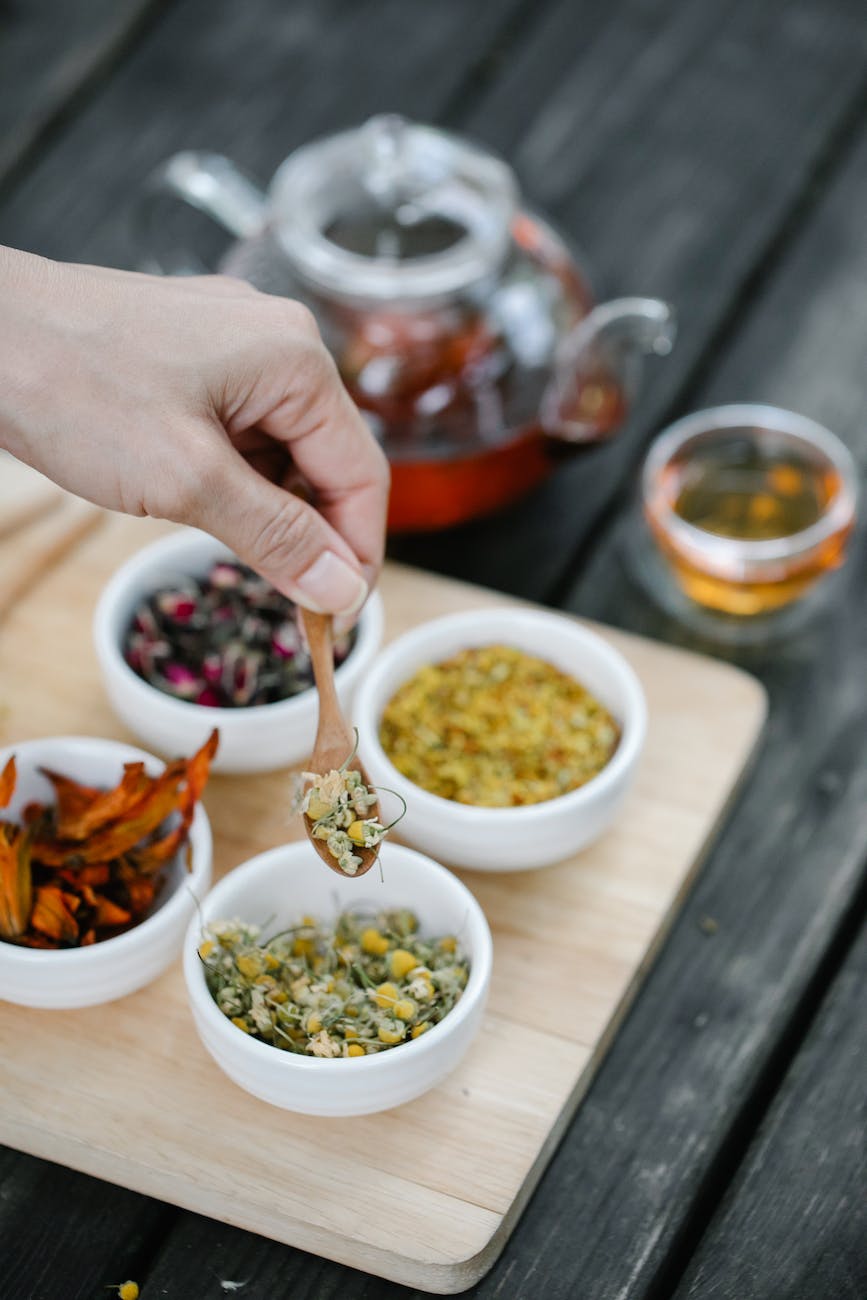
Introduction:
Are you tired of dealing with the relentless discomfort of menstrual cramps every month? You’re not alone. For many, the quest for relief leads to the medicine cabinet, but what if nature could offer a more soothing solution? Welcome to the world of ginger and chamomile teas – your herbal allies in the battle against menstrual woes.
In this post, we’ll delve into the natural magic of these two remarkable teas. Ginger, with its potent anti-inflammatory properties, and chamomile, known for its calming effects, are more than just warm beverages; they are centuries-old remedies embraced for their ability to ease menstrual discomfort. Forget about the temporary fixes from over-the-counter pills. It’s time to explore how these herbal teas can not only reduce pain but also bring harmony to your body during those tough days of the month.
Join us as we unveil the secrets of ginger and chamomile tea, from their rich histories as medicinal herbs to easy, do-it-yourself recipes that promise menstrual relief. Whether you’re a tea enthusiast or a curious newcomer looking to soothe your period pains naturally, this journey through the world of herbal teas is sure to enlighten and comfort. Let’s start brewing a path to a more peaceful menstrual cycle!
Unraveling the Monthly Mystery: Menstrual Discomfort Unpacked
Why Does It Feel Like a Rollercoaster Ride?
Picture this: it’s that time of the month, and your body decides to go on a hormonal rollercoaster. Cramps, bloating, and mood swings – oh my! It’s like a monthly subscription to discomfort you never signed up for. But hey, it’s not just you. It’s a sisterhood experiencing the same ups and downs.
Nature’s Remedy: Going Back to Roots (and Flowers!)
Now, let’s talk about switching gears. Away from the synthetic quick fixes, we’re taking a scenic route through nature’s garden. Why? Because Mother Nature packs a punch with her own brand of menstrual relief. Enter ginger and chamomile – not your average cup of tea!
Brewing Relief: The Dynamic Duo of Ginger and Chamomile
Ginger: The Spicy Secret to Kicking Cramps to the Curb
Let’s spice things up with ginger! This root is like the superhero of the tea world. It swoops in, with its zesty flavor, to save the day. How? By showing those cramps and pains who’s boss. With gingerols acting as its superpower, ginger tea is your ally in this monthly battle.
Chamomile: More Than Just a Sleepytime Tea
Chamomile is the unsung hero of the tea universe. It’s like a warm, gentle hug in a cup. This dainty flower might look delicate, but don’t be fooled – it’s tough on menstrual woes. It soothes cramps, calms the storm of PMS, and even helps you catch those Z’s. It’s like the best friend you need during your period.
Concocting Comfort: Easy Tea Recipes for Tough Times
Ginger Tea: Your Spicy Sidekick in a Cup
Ready to brew some magic? Grab fresh ginger – yes, the knobby, odd-looking root – and let’s get to it. Peel, slice, and then simmer it into submission. The result? A potent, spicy tea that’s a warm embrace for your cramps. Add a squeeze of lemon or a dollop of honey, and voila! You’ve got a mug of fiery relief.
Chamomile Tea: Liquid Tranquility for Turbulent Times
Now, for a gentler touch. Chamomile tea is like the soft-spoken friend who always knows what to say. Steep those delicate flowers in hot water, watch the magic happen, and in a few minutes, you’ll have a cup of serenity. It’s perfect for those nights when your mind is racing faster than a shooting star.
Mix It Up: Custom Blends for Personalized Relief
Your Tea, Your Way
Why stop at just ginger or chamomile? Get creative and make your own menstrual relief concoction. Mix and match with other power players like peppermint, nettle, or even a cinnamon stick for that extra kick. Tailor it to your taste and your body’s needs. It’s like being a tea alchemist, brewing up your unique potion for period relief.
Sip, Relax, Repeat: Creating a Ritual of Self-Care
More Than Just Drinking Tea – It’s a Ritual
This isn’t just about sipping tea; it’s about crafting moments of calm in the chaos. Create a cozy corner, light some scented candles, and let the soft tunes of your favorite playlist fill the air. As you sip your tea, let each thought and worry dissolve. It’s your time to unwind, reflect, and just be.

The Bigger Picture: Tea as a Partner in Hormonal Harmony
Tea – A Sidekick for Your Hormones
Surprise – your cup of tea is more than just a tasty drink. It’s playing the long game, helping keep your hormones in check. With every sip, you’re not just easing symptoms; you’re contributing to a healthier, more balanced you. Think of it as a delicious investment in your overall well-being.
Wrapping It Up: A Toast to Healthier Periods
The Final Sip: Embracing Natural Relief
As we come to the end of our tea-tastic journey, remember that ginger and chamomile are more than just ingredients in your pantry – they’re your allies in the quest for a more peaceful period. These teas aren’t just remedies; they’re a ritual, a way to honor your body and its rhythms.
Your Story, Their Stories: Share and Care
This isn’t just my story or your story; it’s a shared experience across the globe. So, after you’ve tried these teas, why not share your tales? Drop a comment, send a tweet, or start a conversation. Your insights could be the beacon of hope for someone else in the throes of menstrual mayhem.
A Call to Brew and Reflect
Join the Movement: Sip, Share, Support
As you reach for your teapot, remember that each cup is a step towards a more natural and harmonious menstrual cycle. And as you share your experiences, you’re not just spreading knowledge; you’re building a community of support and understanding.
So, here’s to better periods, one cup at a time. Brew, sip, relax, and repeat. Let’s make menstrual wellness a shared journey, filled with warmth, comfort, and, of course, a little bit of tea magic.
FAQs
- How does ginger tea help with menstrual cramps? Ginger tea contains gingerols, which have anti-inflammatory properties. These compounds reduce inflammation and pain, providing relief from menstrual cramps. It’s a natural way to soothe your body without relying on medications.
- Can chamomile tea improve sleep during menstruation? Yes, chamomile tea has natural sedative effects. Drinking it before bed can help calm your mind, ease anxiety, and promote better sleep, especially during the restless nights of your menstrual cycle.
- Are there any side effects of drinking ginger or chamomile tea for menstrual relief? Both teas are generally safe, but excessive consumption might lead to mild side effects. For ginger tea, these can include heartburn or stomach upset. Chamomile is usually very gentle, although allergic reactions are possible, especially if you’re allergic to plants in the daisy family.
- How often should I drink these teas for the best effect on menstrual symptoms? For optimal results, try drinking 2-3 cups of ginger or chamomile tea per day during your menstrual cycle. This regular intake can help manage pain and discomfort more effectively.
- Can these teas help with bloating during periods? Absolutely! Ginger tea is particularly effective in reducing bloating due to its anti-inflammatory properties, while chamomile tea’s anti-spasmodic effects can also alleviate bloating and discomfort.
- Is it better to use fresh or dried ginger/chamomile for the tea? Both fresh and dried forms are effective, but fresh ginger root may offer more potent benefits. For chamomile, dried flowers are commonly used and are very effective in brewing a soothing tea.
- Can men drink ginger and chamomile tea for health benefits? Definitely! While these teas are beneficial for menstrual relief, they also offer general health benefits like improved digestion and stress relief, making them great for everyone, including men.
- How long does it take for the tea to start working on menstrual pain? The relief can vary from person to person, but generally, you might start feeling the effects within 30 minutes to an hour after drinking the tea.
- Can I drink ginger and chamomile tea if I’m on other medications? While these teas are natural, it’s always wise to consult with your healthcare provider, especially if you’re on medication, as there can be interactions with certain drugs.
- Are there any other natural ingredients I can add to these teas for enhanced benefits? Yes, you can add ingredients like honey, lemon, mint, or cinnamon to enhance the flavor and potentially increase the health benefits of the tea.
Blog Tags
menstrual relief, natural remedies, ginger tea, chamomile tea, menstrual cramps, herbal teas, menstrual health, wellness, DIY tea recipes, women’s health












